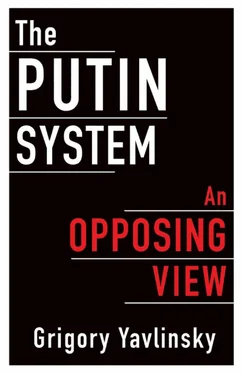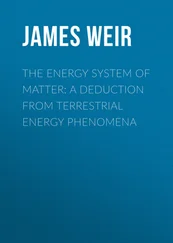Moreover, in some instances, boundaries between competition-based and authoritarian systems of governance are getting blurred. At least one reason for this is the existence of a considerable number of borderline cases, in which no particular group has a clear-cut, single-handed grip on all resources of power across the board and yet the ruling group enjoys such a significant advantage in the distribution of these resources that, in reality, competing groups are not able to apply effective checks and balances on its power. In such instances, the classification of a given system as either competition-based or authoritarian may depend upon the judgment and the personal bias of an individual observer. In addition, because the situation within a given system may fluctuate rapidly, the exact moment of its transition from a competitive to an authoritarian state or vice versa, from one logic of its functioning to another, may be hard to identify and to capture.
Finally, anyone who seeks to get an unbiased grasp of a given situation and to think seriously should, at the very least, be put on guard by peremptory judgments and emotionally colored labels (such as “dictatorship” or “tyranny”) as well as by sweeping historical comparisons. Attempts to hide oneself behind sweeping characterizations are most often used to conceal the lack of information and knowledge about the circumstances. As noted in Oscar Wilde’s The Importance of Being Earnest , “The truth is rarely pure and never simple.” Needless to say, this does not mean that people should not take their stands as citizens or pass value judgments; yet every development and every phenomenon need to be viewed holistically, with all their nuances, contradictions, and complexities.
Another characteristic of political systems that I want to emphasize here is their relationship to such concepts as the public good and societal goals. This is by no means of secondary importance. There is a prevailing view, both among the general public and among authoritative analysts of sociopolitical systems, that the classification of a political system as either competition-based (“democratic”) or authoritarian has no strict relationship to any societal goals that may be pursued by such a system and that may be connected, one way or another, to the notion of public good (such as, for example, acceleration of economic growth, technological and social modernization of the country, and the like).
On the one hand, history provides us with a plenty of examples of political systems under which the freedom of political activities—roughly, competitive elections and alternation of political leaders and parties in power (at times, very frequent alternation), to say nothing of freedom of speech and of the media—coexisted with pervasive corruption, total indifference of the authorities to societal needs, and the decline of order, morale, and public safety. The United States at the start of the twentieth century is perhaps the best example of this. In the post–World War II period, competitive political systems proved to be no panacea against corruption and inefficiency, either in developed countries such as Italy or in the developing world, as, for example, in India and Brazil.
The opposite is also true: there are examples of successful authoritarian modernizations, such as in Singapore, Turkey, South Korea, and, to a certain extent, Japan, where power continuously resided in the hands of a de facto single political force throughout the periods of their high-speed economic growth, while other, less influential political groups were denigrated and denounced. Mainland China and, possibly, Vietnam are the latest examples of countries that are widely viewed as having, at least to some extent, successfully modernized while being under an unquestionably authoritarian political system.
The mainstream of political thinking in Western societies generally views the possibility of accelerated economic growth and modernization under an authoritarian regime as an option applicable only to those countries that have fallen behind in their economic, technological, and social development, and only within a brief historical period of their “catching up” with the West, when their medium-term goals are rather obvious and can be relatively easily articulated in formal terms, becoming the political goals of an authoritarian state. [3] In the course of the twentieth century such authoritarian regimes, sometimes dubbed “developmental dictatorships” in Western literature, viewed themselves through the prism of their attempts to pull their countries out of economic backwardness and to try to catch up with the developed core of the world economy, or even to join it. The Soviet Union can apparently be considered one of those “developmental dictatorships,” at least at some stages of its historical trajectory.
This may very well be true; yet, even with these caveats, we still have to face the actual discrepancy, present over fairly long historical periods, between, on the one hand, the characteristics of a political regime in terms of its internal competitiveness and, on the other, the extent to which it can effectively accomplish large-scale national objectives.
Furthermore, some eminent thinkers, such as, for example, economist Robert Aumann, who won the Nobel Prize in 2005, believe that the longer time horizons enjoyed by authoritarian regimes enable them to achieve the goals of modernization more easily—provided, of course, that they are not corrupted by their lack of accountability and control over their power. Daron Acemoglu and James Robinson, whose works are frequently referred to, claim that the threat of a revolution may compel elites under authoritarian systems to restrain their appetites, to be more rational in their expenses, and to provide larger amounts of public goods. [4] Interview with Robert Aumann, Vedomosti 121 (3135), July 3, 2012; Daron Acemoglu and James A. Robinson, Economic Origins of Dictatorship and Democracy (Cambridge, Mass.: Harvard University Press, 2006); Acemoglu and Robinson, Why Nations Fail: The Origins of Power, Prosperity, and Poverty (London: Profile, 2012).
But, of course, all the ruminations of this kind merely reflect one’s theoretical assumptions; if they can be put to any practical use, it is only to a very limited extent. It is certainly clear that there is no uniform linkage of any kind between the form of government and the motivations of the rulers and that if the ruling group has any motivation whatsoever to modernize the country, such motivation is typically mostly related to the overall attitudes of the political and economic elites and to the personal characteristics of their most active members. It is equally clear that these elites’ intent to modernize is conditioned, to a large extent, by the country’s prior history in its entirety as well as by the characteristics of the structure of its economy, the extent of its participation in the world economic system and international political institutions, and so forth.
All this will be applied in more detail to the case of Russia in other parts of this book. In the meantime, let me note as a matter of fact that a goal-oriented design of any political system, organized with a view toward the pursuit of the goals related to economic growth and modernization, is a feature that stands altogether apart and must be analyzed on its own.
A final issue worth mentioning here, in relation to the widespread classification of political systems and the terminology attached to it, is about the character of the equilibrium in a political system and the direction in which any such model or system may be developing. Setting aside for the time being the causes of and the driving forces that define the direction of development of a given political system, let us note that a political system may be either dynamic or static. If its specific elements are changing to adapt to life’s demands, if they help to remove the barriers that have emerged on the path of the development of society, if they form the requisite new institutions in response to societal demands, then it is a dynamic system. However, if within its framework there are forces and mechanisms that basically work to forestall changes within the system, to extinguish every external attempt to introduce change and instead to keep bringing the system back to an equilibrium of stagnation, then such a system tends to stagnate and to suppress change.
Читать дальше












